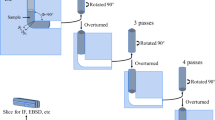Abstract
The micromechanisms of fracture of a spheroidised A533B reactor pressure vessel steel over the temperature range of −190°C to + 60°C were investigated by performing uniaxial tensile tests on double-notched cylindrical specimens. Failure was by quasi-cleavage at temperatures between −190°C and −145°C. Quasi-cleavage fracture surfaces are characterised by clusters of planar facets that are separated from other facets either by large voids or by clusters of microvoids. At temperatures between −145°C and −25°C failure was by mixed microvoid coalescence and cleavage while complete microvoid coalescence was observed at temperatures higher than −25°C. Over the whole temperature range studied, fracture nucleation was either from large single voids or localised regions of microvoids.
Similar content being viewed by others
References
Bošanský J and Šmida T (2002). Deformation twins—probable inherent nuclei of cleavage fracture in ferritic steels. Mat Sci Eng A 323: 198–205
Bouchet C, Tanguy B, Besson J, Pineau A, Bugat S (2006) Transferability of cleavage fracture parameters between notched and cracked geometries. Proceedings of the 16th European Conference of Fracture, Alexandrapoulis-Greece, July 3–7,~2006
Coates M, Kumar A and Roberts SG (2006). Crack initiation in the brittle fracture of ferritic steels. Fatigue Fract Engng Mater Struct 29(9–10): 661–671
Cottrell AH (1958). Theory of brittle fracture in steel and similar metals. Trans Am Inst Min Metall Petrol Engrs 212: 192–203
Dinsdale AT, Hodson SM, Barry TI and Taylor JR (1989). Computer software in chemical and extractive metallurgy. Pergamon Press, Oxford
Edsinger K, Odette GR, Lucas GE (1997) Cleavage-quasi cleavage in ferritic and martensitic steels. In: Chan KS (ed) George R. Irwin Symposium on Cleavage Fracture, 221 pp, Indianapolis-USA, September 14–18, 1997
Edsinger K, Odette GR, Lucas GE and Sheckherd JW (1996). Effect of size, crack depth and strain rate on fracture toughness-temperature curves of a low activation martensitic stainless steel. J Nucl Mat 233: 342–346
Hohe J, Friedmann V, Siegele D (2006) On the local conditions for cleavage initiation in ferritic steels. Proceedings of the 16th European Conference of Fracture, Alexandrapoulis-Greece, July 3–7, 2006
Knott JF (1997) Recent advances in the micro-modelling of cleavage fracture in steel. In: Chan KS (ed) George R. Irwin Symposium on Cleavage Fracture, pp. 171–182, Indianapolis-USA, September 14–18, 1997
Kumar A, Roberts SG, Wilkinson AJ (2006) Relating cleavage nucleation to fractured spheroidal carbides in A553B steel. Proceedings of the 16th European Conference of Fracture, Alexandrapoulis-Greece, July 3–7, 2006
Lawn BR and Wilshaw TR (1975). Fracture of brittle solids. Cambridge University Press, Cambridge, UK
Lindley TC, Oates G and Richards CE (1970). A critical appraisal of carbide cracking mechanisms in ferrite/carbide aggregates. Acta Metall 18: 1127–1136
Marakumi Y (1987). Stress intensity factors handbook. Pergamon Press, Oxford
Odette GR (1994). On the ductile to brittle transition in martensitic stainless steels—mechanisms, models and structural implications. J Nucl Mat 212: 45–51
Oyanagi M, Suzuki T and Yamada K (2002). Development of quasi-cleavage crack leading to fracture of hydrogen charged high strength steel. J Soc Mat Sci Jpn 51: 561–566
Sleeswyk AW and Mandziej S (1990). Precursory cracks in cleavage fracture propagation. Scripta Metall Mater 24(5): 863–869
Stroh AN (1957). A theory of the fracture of metals. Adv Phys 6: 418–465
Wallin K (2002). Master curve analysis of the ‘Euro’ fracture toughness data set. Eng Frac Mech 69: 451–481
Wang GZ and Chen JH (1996). A comparison of fracture behaviour of low alloy steel with different sizes of carbide precipitates. Metall Mat Trans A 27: 1909–1917
Zener C (1948) The micromechanism of fracture, In Irwin G. (ed) Fracturing of metals. American Society for Metals, Cleveland
Author information
Authors and Affiliations
Corresponding author
Rights and permissions
About this article
Cite this article
Kumar, A., Roberts, S.G. & Wilkinson, A.J. Low-temperature fracture mechanisms in a spheroidised reactor pressure vessel steel. Int J Fract 144, 121–129 (2007). https://doi.org/10.1007/s10704-007-9084-3
Received:
Accepted:
Published:
Issue Date:
DOI: https://doi.org/10.1007/s10704-007-9084-3




